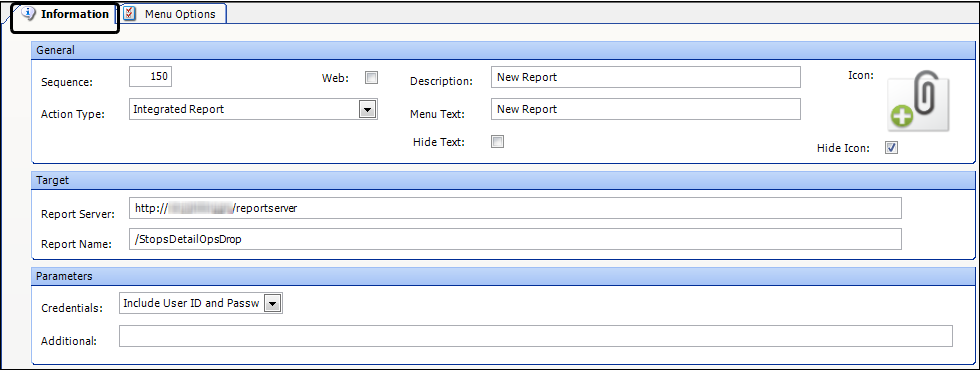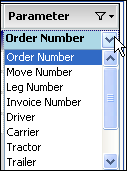
Seq | Displays each command’s sequence number (10, 20, 30, etc.), which determines the order in which commands are listed under a menu. |
Description | Displays the text entered in a command’s Description field. |
Menu Text | Displays the text entered in a command’s Display Text field. This is the command’s name as it will appear in an application’s menu. |
Menu Action type | Displays the option selected as a command’s Menu Action Type when the command was defined. |
Web | Displays whether the command launches a Web page. |
Icon | Displays an icon for the custom command if an icon has been set. Note: If a custom icon is not set, a default icon  will appear for the custom command when it is applied to a menu. will appear for the custom command when it is applied to a menu. |

Sequence | The sequence number is an identifier for the custom command that can be used as a method of sorting the list. • For existing custom commands, the Sequence field displays the sequence number of the custom command that is highlighted in the existing custom commands grid. • When you define a new custom command, the command is added to the end of the grid, and the Sequence field defaults to the next available whole decade (40, 50, 60, etc.). |
Web | By default, the File to Open field lists parameters to add to the command line in the sequence they appear in the Menu Options tab. If this check box is selected, you will need to add any parameters to the File to Open field manually. |
Description | Free-form text that describes the custom command. |
Action Type | This drop-down list provides options that define the type of action the custom command will perform: • Run Program • Used to run an executable file, such as .EXE, .COM, .BAT, and .VBS, specified in the Target field. See Defining a custom command to run an executable file. • Used to run an Internet browser and open a Web page. See Defining a custom command to launch a Web page. • Integrated Report Used to run an Integrated Report. See Defining a custom command to run an Integrated Report. |
Menu Text | Free-form text for the custom command default name as it is to appear in an application’s menu. Note: If you change the display text for a custom command using the Customize dialog box, you should record the name. This can be done in the Description field. |
Hide text | This check box indicates whether the Menu text for the custom command will display in a menu. |
Hide icon | This check box indicates whether the Icon for the custom command will display in a menu. |
Icon | Displays an icon for the custom command if an icon has been set. Note: If a custom icon is not set, a default icon  will appear for the custom command when it is applied to a menu. will appear for the custom command when it is applied to a menu. |
Target | This field records the path to the program to be executed by the custom command. If needed, use the Browse button to locate the program. Executable files include these extensions: .EXE, .COM, .BAT, and .VBS. You can also identify files that are associated with known executables, such as .MPS, .JPG, and .docx. Note: The program file can be anywhere on your system, as long as the correct path and file name appear in this field. If the path or file name is incorrect, the custom command can be assigned to a menu, but it will be inoperative. |
File to Open | If the program specified in the Target field is to open a specific file, record the path to that file. If needed, use the Browse button to locate the file. |
Report Server | Displays the address for the report server. |
Report Name | Displays the name of the Integrated Report that will be run. |
Credentials | If the custom command launches an application that requires access to the TMWSuite database, and you are not using Windows authentication, this field is used to enable the custom command to pass the user’s TMW login ID and password, or login ID only, as command line parameters. The options in this drop-down list are: • Do not include • Include User ID and Password • Include User ID only |
Additional | If the program is to process additional run-time parameters, enter them in this field in the format required by the program. |

Seq | This read-only sequence number column displays the order in which the menu options defined in the Menu Options grid will be attached to the custom command. Note: If the Credentials field is set to include the user ID, or user ID and password, the Menu Option parameters will follow the user ID/password in the order shown in the Seq fields. | |
Option | This read-only column displays Parameter for each row added to the Menu Options grid. | |
Parameter |  | This selection field specifies the type of record number or ID that will be passed as a menu option parameter. |

Add | To append a row to the bottom of the grid, click the Add button. |
Remove | To delete the currently selected row, click the Delete button. A confirmation message is shown. |